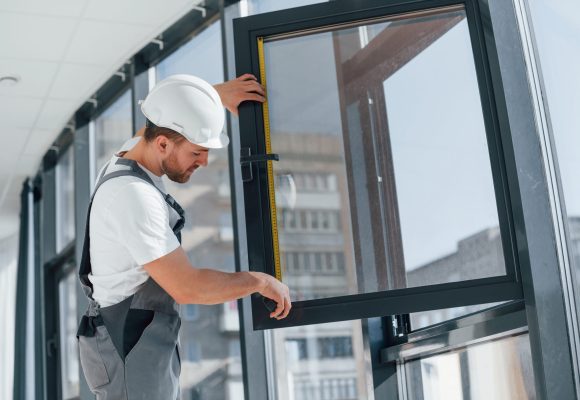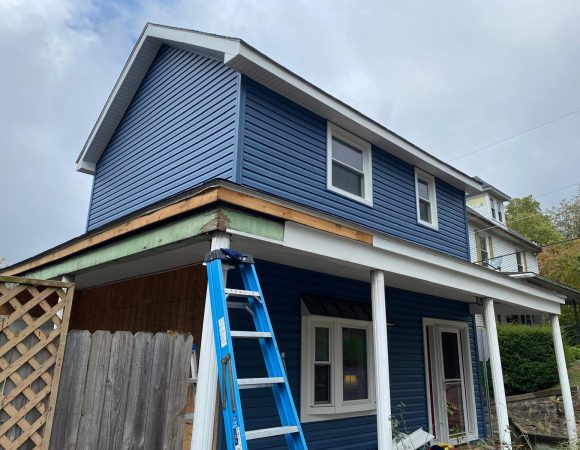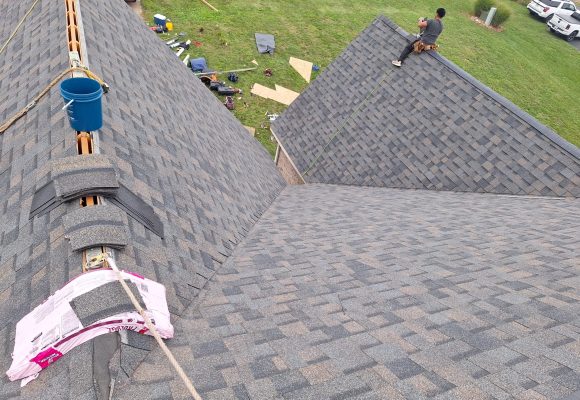BLOG
TOP 5 BENEFITS OF INSTALLING NEW WINDOWS IN YOUR HOME
When it comes to improving your home’s energy efficiency, appearance, and overall value, installing new windows is one of the best investments you can make. At CH Espinoza Construction LLC, we specialize in providing high-quality window installation services that will not only enhance your home’s aesthetic but also provide long-term benefits. Here are the top 5 reasons why you should consider upgrading to new windows:
1. Improved Energy Efficiency
One of the most significant benefits of installing new windows is enhanced energy efficiency. Older windows, especially those with single panes, tend to allow drafts and air leaks, causing your heating and cooling systems to work harder. This leads to higher energy bills.
Double or Triple Glazing: New windows often feature double or even triple glazing, which offers better insulation, keeping warm air in during winter and cool air in during summer.
Low-E Glass Coating: Many new windows come with Low-Emissivity (Low-E) coatings that reflect heat while allowing light to pass through, which helps maintain a comfortable indoor temperature year-round.
By reducing heat loss and gain, new windows can significantly lower your energy bills and reduce your home’s carbon footprint.
2. Enhanced Curb Appeal
New windows can instantly improve the curb appeal of your home. Whether you're looking to update your home's style or just replace aging, worn-out windows, installing modern windows can transform the overall look of your property.
Variety of Styles: From sleek, modern designs to classic and traditional styles, new windows come in a wide range of options that can complement the architectural style of your home.
Increased Home Value: Updating your windows is a cost-effective way to increase the resale value of your home. Potential buyers often look for homes with energy-efficient and aesthetically appealing features.
With the right windows, you can give your home a fresh, updated look while making it more attractive to future buyers.
3. Better Noise Insulation
If you live in a busy area with a lot of external noise (traffic, neighbors, or nearby construction), new windows can help reduce sound transmission into your home. Modern windows are designed with thicker glass and air-tight seals, which block outside noise more effectively than older windows.
Soundproofing: Double or triple-pane windows offer better sound insulation, allowing you to enjoy a quieter, more peaceful indoor environment.
Improved Comfort: Less noise intrusion means less distraction and a more comfortable living space, whether you’re relaxing, working, or sleeping.
By replacing old windows with high-quality, soundproofing models, you can make your home a quieter sanctuary.
4. Increased Home Security
Older windows can compromise the safety of your home. Worn-out locks, single-pane glass, and weak frames make it easier for intruders to break in. Upgrading to new windows can offer enhanced security features to protect your home and loved ones.
Stronger Frames & Glass: New windows are made from stronger materials, such as reinforced frames and laminated glass, which are more resistant to breakage.
Advanced Locking Mechanisms: Modern windows come equipped with advanced locking systems, providing an extra layer of security and peace of mind.
New windows can make it much harder for burglars to gain access to your home, improving your overall home security.
5. Low Maintenance & Durability
New windows are designed to be low-maintenance and more durable than their older counterparts. Many modern windows come with features that make cleaning and maintaining them a breeze.
Self-Cleaning Glass: Some windows feature self-cleaning coatings, which reduce the need for frequent cleaning by using sunlight and rain to break down dirt and debris.
Durable Materials: Modern windows are made from materials such as vinyl, fiberglass, and aluminum, which require less maintenance and resist warping, rotting, or fading over time.
Long-Term Investment: Although the initial cost of new windows can be higher, their durability and low-maintenance features make them a smart long-term investment, saving you money on repairs and upkeep.
With modern windows, you’ll spend less time and money on maintenance, leaving you with more time to enjoy the comfort and beauty of your home.

THE IMPORTANCE OF REGULAR GUTTER MAINTENANCE
When it comes to protecting your home from water damage, your gutters play a critical role. Often overlooked, gutters are one of the most important features of your home’s exterior. Regular gutter maintenance ensures that they function properly and help prevent costly repairs down the line. At CH Espinoza Construction LLC, we emphasize the importance of maintaining clean, functional gutters for your home’s protection.
Here’s why gutter maintenance should be a priority for every homeowner:
1. Prevent Water Damage to Your Home
The primary function of gutters is to direct rainwater away from your home’s foundation, walls, and roof. When gutters become clogged with leaves, dirt, or debris, they can’t perform this crucial task, which can lead to water pooling around your home. Over time, this water can seep into your foundation, causing cracks, settling, and even flooding in your basement.
Foundation Protection: Clogged gutters can cause water to overflow and pool near your home’s foundation, potentially leading to costly foundation repairs.
Wall & Siding Protection: Water that overflows from blocked gutters can damage your home’s exterior, causing rot or mold growth on your walls and siding.
Roof Protection: Excess water can back up into your roofline, damaging your roofing materials and causing leaks or even structural damage.
Regularly cleaning and inspecting your gutters ensures that they direct water away from your home, preventing unnecessary damage.
2. Preventing Pest Infestations
Clogged gutters are the perfect breeding ground for pests like mosquitoes, rodents, and insects. When water collects in your gutters due to blockages, it creates standing water that attracts mosquitoes and other pests. The debris in your gutters can also become a nesting site for rodents, birds, and even insects.
Mosquitoes & Insects: Standing water in clogged gutters is an ideal breeding ground for mosquitoes, which can carry diseases. It also attracts other insects that may eventually make their way into your home.
Rodents & Birds: Piles of debris in gutters can become nesting material for rodents and birds, leading to infestations. This can not only be a nuisance but also lead to additional repairs.
By maintaining your gutters regularly, you help eliminate the conditions that attract pests to your home.
3. Avoiding Costly Repairs
Gutter maintenance is a relatively inexpensive task compared to the cost of repairs caused by neglected gutters. When gutters are left unchecked, the damage caused by water overflow can affect the roof, siding, landscaping, and foundation, leading to expensive repairs.
Roof Repairs: Water damage to your roof caused by overflowing gutters can result in leaks, mold, or even the need for roof replacement.
Siding & Landscaping Damage: Overflowing water can erode your landscaping and damage your siding, leading to costly repairs or replacements.
Cleaning your gutters regularly is a small investment in avoiding potentially significant repair costs in the future.
4. Enhancing the Lifespan of Your Gutters
Regular gutter maintenance not only prevents damage to your home but also extends the lifespan of your gutters. Over time, leaves, twigs, and debris can cause your gutters to rust, crack, or even sag, which can lead to gutter replacements.
Clog-Free Gutters: Keeping your gutters clear ensures that the water flows freely, reducing the risk of rust and wear on the gutters.
Prevent Sagging: When gutters are clogged, they can become heavy and start to sag. This can cause the gutter system to pull away from the house, leading to expensive repairs.
By keeping your gutters clean and well-maintained, you help preserve their structure and functionality for years to come.
5. Preventing Ice Dams in Winter
In colder climates, clogged gutters can lead to ice dams during the winter months. When water is trapped in blocked gutters and freezes, it creates a dam that prevents further water from draining. This trapped water can then back up under your roof, causing leaks and water damage to your attic and ceilings.
Ice Dams: Regularly cleaning your gutters before winter helps prevent the accumulation of debris that could lead to ice dams.
Waterproofing Your Home: Clean gutters ensure that water flows freely through the system, reducing the risk of ice dams forming on your roof.
Maintaining your gutters before the winter months can help prevent the costly damage caused by ice dams.

HOW TO CHOOSE THE RIGHT ROOFING MATERIAL FOR YOUR HOME
Choosing the right roofing material is one of the most important decisions you’ll make when it comes to protecting your home. The roof is your home’s first line of defense against the elements, and selecting the right material ensures that it will provide durability, energy efficiency, and aesthetic appeal for years to come. With so many options available, how do you know which one is best for your needs?
At CH Espinoza Construction LLC, we’re experts in roofing, and we’re here to help you navigate the process of choosing the ideal roofing material for your home. Here are the key factors to consider when selecting a roofing material:
1. Climate and Weather Conditions
The climate in your region plays a significant role in determining the best roofing material for your home. Some materials perform better in specific weather conditions than others, so it's important to consider factors like temperature, rainfall, and snow.
Hot & Sunny Climates: If you live in a hot and sunny area, metal roofing or clay tiles are great options. These materials reflect heat, keeping your home cooler in the summer.
Cold & Snowy Climates: In areas that experience cold winters and heavy snowfall, asphalt shingles or metal roofing are ideal. These materials shed snow easily and prevent ice dam formation.
Rainy Areas: For regions with heavy rainfall, slate roofing or asphalt shingles work well, as they offer excellent waterproofing and prevent leaks.
Consider the typical weather patterns in your area to select the roofing material that will best withstand the local climate.
2. Durability and Lifespan
The durability of your roof is essential for ensuring long-term protection for your home. Different roofing materials have varying lifespans, so consider how long you want your roof to last before needing a replacement.
Asphalt Shingles: These are the most common and affordable roofing material. They typically last between 20-30 years with proper maintenance.
Metal Roofing: Known for its durability, a metal roof can last anywhere from 40-70 years, making it a great long-term investment.
Clay or Concrete Tiles: These can last 50-100 years with proper care and are highly resistant to harsh weather conditions.
Slate Roofing: Slate is incredibly durable and can last 75-200 years, although it comes at a higher upfront cost.
If you want a roofing material that will stand the test of time, investing in options like metal, slate, or clay tiles might be a wise choice.
3. Aesthetic Appeal
Your roof greatly influences the overall look of your home, so it’s important to choose a roofing material that complements your style and enhances your curb appeal.
Asphalt Shingles: These come in a wide range of colors and styles, including traditional and architectural options, allowing you to match your home’s exterior.
Wood Shingles or Shakes: Wood roofing materials provide a rustic, natural aesthetic that’s perfect for homes with a traditional or cottage-style appearance.
Metal Roofing: Metal roofs offer a modern look and can be made to mimic other materials such as wood or tiles. They’re available in various colors and finishes to suit your design preferences.
Slate and Clay Tiles: These materials offer a classic, elegant appearance that is perfect for Mediterranean, Spanish, or Victorian-style homes.
Consider the architectural style of your home and the neighborhood when selecting a roofing material that enhances its overall appearance.
4. Budget
Your budget plays a significant role in determining the best roofing material for your home. Different materials come at various price points, and it’s important to balance quality with cost.
Asphalt Shingles: These are the most affordable option and typically cost between $100 - $200 per square (100 square feet).
Metal Roofing: Metal roofs are more expensive, ranging from $300 - $900 per square, but they offer excellent durability and energy efficiency.
Wood Shingles: These are typically priced between $400 - $700 per square, depending on the type of wood and craftsmanship.
Slate Roofing: Slate roofs are among the most expensive, often costing $600 - $1,500 per square, but they provide unmatched durability and a timeless aesthetic.
While asphalt shingles are the most cost-effective option, investing in higher-end materials like metal or slate may offer better long-term value due to their extended lifespans and durability.
5. Energy Efficiency
Roofing materials can impact your home’s energy efficiency, which in turn affects your utility bills. Some materials are designed to reflect heat and reduce cooling costs, while others provide better insulation.
Metal Roofing: Metal roofs are highly reflective and help keep your home cooler in the summer, reducing the need for air conditioning and lowering your energy bills.
Clay and Concrete Tiles: These materials also offer excellent heat resistance and are naturally energy-efficient, helping to keep your home cooler in hot weather.
Asphalt Shingles: While traditional asphalt shingles absorb heat, cool roof shingles (which are coated with reflective granules) can help improve energy efficiency by reflecting sunlight.
If you live in a hot climate or want to improve your home’s energy efficiency, materials like metal, clay, or concrete tiles are great choices.

WHY DEMOLITION SHOULD BE LEFT TO THE PROFESSIONALS
Demolition may seem like a straightforward task, but it involves more than just tearing down walls or structures. Whether you're looking to renovate a part of your home or remove an outdated building, it’s crucial to understand the importance of professional demolition services. At CH Espinoza Construction LLC, we specialize in safe, efficient demolition work. Here’s why demolition should always be left to the professionals:
1. Safety First: Protecting People and Property
One of the main reasons to hire professional demolition contractors is safety. Demolition can be dangerous if not done correctly, and improper techniques can result in injury or damage to your property.
Structural Integrity: When demolishing a part of a building or home, professionals ensure that the structural integrity of the remaining areas is not compromised. They understand how to safely remove walls, floors, or roofs without affecting other parts of the structure.
Safety Protocols: Trained demolition experts follow strict safety protocols to ensure the protection of both workers and homeowners. This includes using proper equipment, wearing protective gear, and ensuring that the demolition site is secure.
By hiring experts, you minimize the risk of accidents and injuries during the demolition process.
2. Proper Equipment and Tools
Demolition requires specialized equipment and tools that most homeowners don’t have access to. Professionals come equipped with the necessary machinery to handle a range of demolition tasks safely and efficiently.
Heavy Machinery: Excavators, bulldozers, and cranes are just a few examples of the heavy machinery used in demolition projects. Professionals have the skills to operate these tools, ensuring they’re used properly to avoid accidents.
Demolition Tools: Tools like jackhammers, wrecking balls, and saws are essential for breaking down different materials. Professionals are trained in using these tools to get the job done effectively while minimizing damage.
Without the right equipment, DIY demolition can result in time-consuming work, costly repairs, or even injury.
3. Hazardous Materials Management
Many older buildings contain hazardous materials like asbestos, lead paint, or mold, which can pose serious health risks if not handled properly during demolition.
Asbestos Removal: Asbestos is a common material found in buildings constructed before the 1980s. It can cause serious health issues, including lung cancer, if disturbed improperly. Professional demolition contractors are trained in safely removing and disposing of asbestos.
Lead Paint: Lead-based paints, which were common in homes before 1978, can pose a health hazard, especially to children and pregnant women. Professionals are equipped to handle and remove lead paint according to safety guidelines.
Mold and Mildew: Older homes may also have mold or mildew, which can trigger respiratory issues. A professional team knows how to properly deal with these dangerous materials and prevent further exposure.
Professionals are trained to identify and manage hazardous materials, ensuring your health and safety throughout the demolition process.
4. Waste Disposal and Recycling
Demolition creates a significant amount of debris, which must be disposed of properly to avoid environmental damage or legal issues.
Efficient Waste Removal: Professionals are equipped to remove large amounts of debris quickly and efficiently, saving you time and effort. They can also separate reusable materials, such as wood, metal, or concrete, for recycling or repurposing.
Environmental Responsibility: Professional demolition companies often have protocols in place for sustainable disposal. They know where to take materials to recycling centers and ensure that hazardous waste is disposed of in accordance with local laws and regulations.
Without proper disposal, demolition debris can pile up and result in environmental hazards or violations of local regulations.
5. Permits and Legal Compliance
Demolition work, especially on residential or commercial buildings, often requires permits and adherence to local laws and regulations. Professionals are familiar with these requirements and can handle all the necessary paperwork for you.
Obtaining Permits: A licensed demolition contractor will know exactly which permits are required for your project and will ensure that they are obtained before starting the work. Failure to obtain the proper permits can lead to costly fines or even project delays.
Regulatory Compliance: Demolition projects must comply with local zoning laws, environmental regulations, and safety standards. Professionals are familiar with these rules and will ensure the demolition is carried out legally and safely.
Trying to handle the paperwork and permits on your own can be time-consuming and overwhelming. By hiring a professional, you ensure that your demolition project meets all legal requirements.

